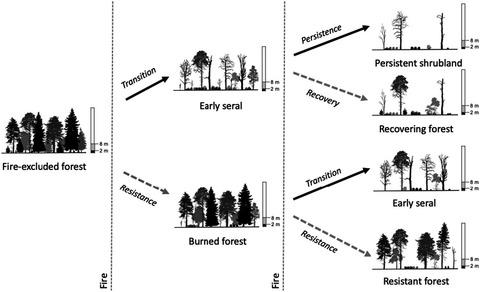Our official English website, www.x-mol.net, welcomes your
feedback! (Note: you will need to create a separate account there.)
Ecological resilience and vegetation transition in the face of two successive large wildfires
Journal of Ecology ( IF 5.3 ) Pub Date : 2021-08-13 , DOI: 10.1111/1365-2745.13764 Zachary L. Steel 1 , Daniel Foster 1 , Michelle Coppoletta 2 , Jamie M. Lydersen 3 , Scott L. Stephens 1 , Asha Paudel 4 , Scott H. Markwith 4 , Kyle Merriam 2 , Brandon M. Collins 5, 6
中文翻译:

面对连续两次大型野火的生态恢复力和植被转型
更新日期:2021-08-30
Journal of Ecology ( IF 5.3 ) Pub Date : 2021-08-13 , DOI: 10.1111/1365-2745.13764 Zachary L. Steel 1 , Daniel Foster 1 , Michelle Coppoletta 2 , Jamie M. Lydersen 3 , Scott L. Stephens 1 , Asha Paudel 4 , Scott H. Markwith 4 , Kyle Merriam 2 , Brandon M. Collins 5, 6
Affiliation

|
- Wildfire can both promote and erode resilience to future disturbances in fire-adapted ecosystems. Through a combination of past fire exclusion and climate change, fire patterns and successional trajectories are shifting with potentially negative consequences for forest resilience. In particular, high-severity short-interval reburns can lead to permanent transitions from forested to persistent non-forested ecosystems.
- To test conditions under which wildfires promote resilience or initiate vegetation transitions we leveraged high-resolution LiDAR data, field data and a natural experiment where two uncharacteristically severe wildfires burned the same area in California's Sierra Nevada mountains. Specifically, we evaluate what factors influence resistance to high-severity reburn and whether early forest recovery is evident following vegetation transition.
- Our findings indicate that topography and vegetative structure influenced resistance to high-severity effects of a second wildfire and that environmental heterogeneity played an important role. Forests that survived the initial burn were most resistant to subsequent high-severity fire when they were characterized by relatively dense but heterogeneous upper strata and a sparse understorey, located in variable and mesic terrain and burned under milder fire weather conditions. Early seral vegetation was most likely to resist repeat high-severity fire and potentially continue post-fire forest recovery when it was located in variable and mesic terrain and was characterized by relatively sparse understorey vegetation and a heterogeneous subcanopy. Some early seral areas that reburned at lower severity showed signs of conifer forest recovery. Vegetation structure and composition of areas that repeatedly burned at high severity are consistent with a transition to persistent shrubland or hardwood forests.
- Synthesis. Short-interval reburns close to historical fire intervals but of unusually high burn severity can create challenges for maintaining resilient forests, as sequential fires can expand upon and stabilize non-forest vegetation. However, forest communities that survive such disturbances appear partially restored with increased structural heterogeneity and greater resistance to future high-severity fire. If climate and fire regime trends continue, we are likely to see broadscale shifts towards vegetation types and species able to recover quickly from high-severity fire at the expense of forests and species resistant to frequent low-severity fire.
中文翻译:

面对连续两次大型野火的生态恢复力和植被转型
- 野火既可以促进也可以削弱适应火灾的生态系统对未来干扰的恢复能力。通过过去的火灾排除和气候变化的结合,火灾模式和演替轨迹正在发生变化,对森林恢复力可能产生负面影响。特别是,高强度的短时间间隔再燃烧可能导致从森林生态系统到持久非森林生态系统的永久转变。
- 为了测试野火促进恢复力或启动植被转变的条件,我们利用高分辨率 LiDAR 数据、现场数据和自然实验,其中两场异常严重的野火燃烧了加利福尼亚内华达山脉的同一区域。具体而言,我们评估了哪些因素会影响对高强度再烧的抵抗力,以及植被过渡后早期森林恢复是否明显。
- 我们的研究结果表明,地形和植物结构影响了对第二次野火的高强度影响的抵抗力,并且环境异质性发挥了重要作用。在最初的燃烧中幸存下来的森林最能抵抗随后的高强度火灾,因为它们的特点是上层相对密集但不均匀,下层稀疏,位于多变的中湿地形并在较温和的火灾天气条件下燃烧。早期的热带植被最有可能抵抗反复发生的高强度火灾,并有可能继续火灾后森林恢复,因为它位于多变的中湿地形,其特征是相对稀疏的下层植被和异质的亚冠层。一些以较低严重程度重新燃烧的早期热带地区显示出针叶林恢复的迹象。
- 合成。接近历史火灾间隔但燃烧严重程度异常高的短间隔重新燃烧会给保持弹性森林带来挑战,因为连续火灾可以扩大并稳定非森林植被。然而,在此类干扰中幸存下来的森林群落似乎部分恢复,结构异质性增加,对未来高强度火灾的抵抗力更强。如果气候和火势趋势继续下去,我们很可能会看到植被类型和物种的大规模转变,这些植被类型和物种能够从高强度火灾中快速恢复,而代价是森林和物种对频繁的低强度火灾具有抵抗力。











































 京公网安备 11010802027423号
京公网安备 11010802027423号